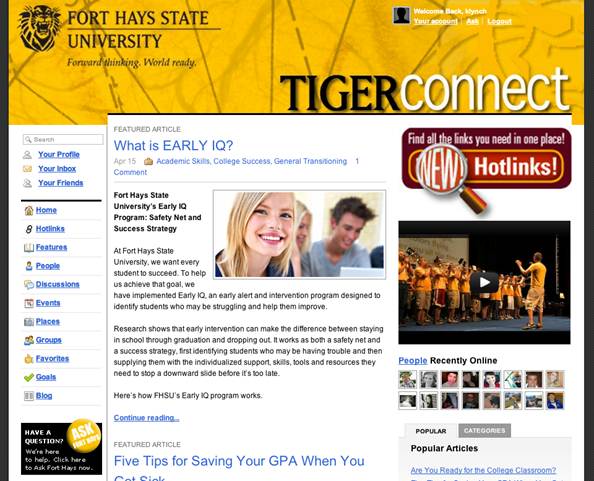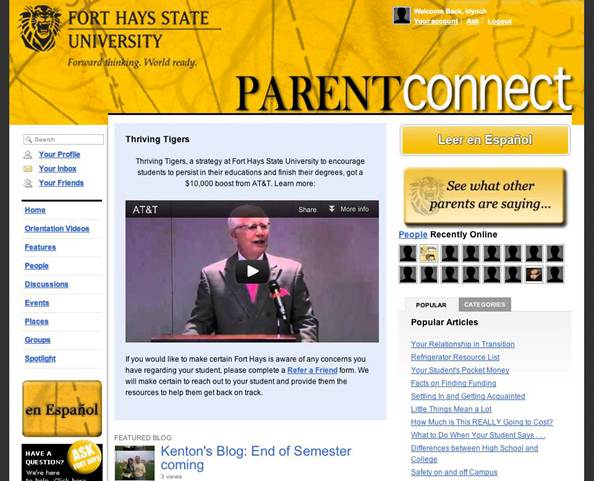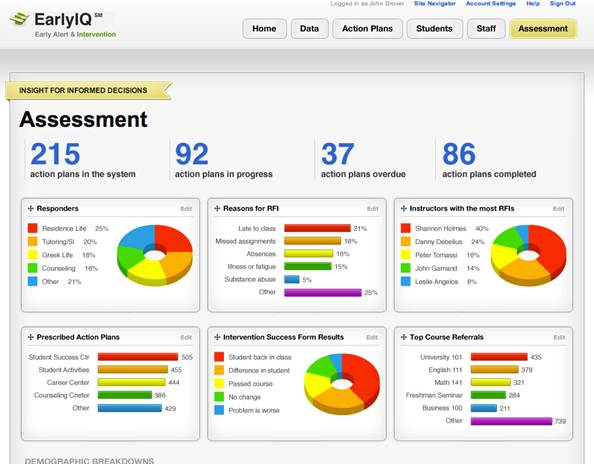Key Takeaways
- Using and tracking online technologies such as networks for the purpose of improving student retention has been challenging for universities with limited resources.
- Fort Hays State University partnered with ConnectEDU to develop a purpose network focused on improving student and parent engagement, increasing student retention rates, and tracking and collecting success metrics.
- Using a three-pronged approach — student engagement, parental engagement, and at-risk identification — Fort Hays State University sees positive results both qualitatively and quantitatively for on-campus and virtual students and families.
Increasing student retention through purposeful engagement online has always been a challenge for institutions. With advances in technology and purpose networking, institutions can explore new and interesting ways to communicate and market to students. The success and effectiveness of these new methods is controversial or undocumented, at best. To improve student engagement, Fort Hays State University (FHSU) needed a defensible solution for increasing the impact of campus communications that provided the ability to track key success metrics, implement intervention plans, and, as a result, increase student retention.
The Fort Hays State University Approach
FHSU is a not-for-profit public institution located in Hays, Kansas. This institution serves more than 12,000 on-campus students and more than 8,000 virtual college students from nearly every state within the U.S. and more than 20 countries around the world. For the past five years, FHSU has emphasized engaging and retaining students while working with limited state resources.
Prior to working with ConnectEDU, the university did extensive research into the company and the technologies the company provides. ConnectEDU was selected for their flexibility, support, and help thinking through best practices that are consistent with the FHSU culture and recent trends.
Developing a Purpose Network, the Thriving Tigers
FHSU created a purpose network, the Thriving Tigers program, playing on the school's tiger mascot. The program implemented three of ConnectEDU's products: FYRe, Parent FYRe, and EarlyIQ.
FYRe
The First-Year Retention Experience (FYRe) is an online network designed to engage students in campus life, as well as identify and address student and campus needs. Through the closed network, campuses can clearly define expectations, present student support efforts, and increase campus integration from orientation through the first year. FYRe also provides campuses with engagement and satisfaction metrics on topics such as student satisfaction with the campus, student involvement on campus, perceived academic ability, interest in student organizations, and familial support. ConnectEDU provides Fort Hays annual reporting for engagement metrics and impact on retention. The latest report shows that student users were retained on average at a 22 percent higher rate than nonusers.
The university branded their FYRe program "TigerConnect" (figure 1). The retention rate of students using TigerConnect's first-year program for the 2010 academic year shows positive early results compared to nonusers (figure 2).

Figure 1. FHSU FYRe program TigerConnect

Figure 2. Retention rate of users vs. nonusers of TigerConnect first-year program
Parent FYRe
The Parent First-Year Retention Experience is designed to increase engagement and campus integration with the parents of students. Institutions use the Parent FYRe to clearly communicate student support efforts and areas of interest for both students and their families. FHSU branded their Parent FYRe "ParentConnect" (figure 3).

Figure 3. FHSU parent retention program ParentConnect
EarlyIQ
The early alert and intervention product increases student retention by identifying students at risk of dropping out and enabling faculty and staff to intervene in a timely way. EarlyIQ is administrator- and faculty-facing software that collects behavioral, academic, and demographic information to identify at-risk students. With EarlyIQ, the campus can also implement intervention plans (action plans), track student progress, and communicate with other faculty. FHSU branded their EarlyIQ program "TigerIQ" (figure 4).

Figure 4. FHSU EarlyIQ program TigerIQ
The Thriving Tigers Purpose Network in Action
The overarching goal of the Thriving Tigers program was to boost student retention rates by increasing student engagement with the university and the campus community. FHSU wanted to use technology to streamline and analyze student integration efforts and the effect of action plans such as student failing assignments. Knowing that students who feel as though they are part of a campus community and complete their first year with a 2.5 or higher are more likely to be retained and graduate, we targeted first-year students and their families with ConnectEDU's FYRe (2009), EarlyIQ (2011), and Parent Retention Program (2010) products.
Step 1: Implementing TigerConnect
FHSU started with the implementation of TigerConnect as the one-stop shop for students moving through their first year, in spring 2009. By providing academically and socially purposeful material via articles, surveys, discussion areas, and goals, the school could review trends, see student concerns, and provide a clear direction for the students from the campus perspective. TigerConnect began allowing optional enrollment to all first-year (including traditional and transfer population) students into the program. FHSU also used the program to speak directly to the students, promote their communication with their peers and faculty, and provide on-demand content related to common first-year issues like time management, exercise, and communication. In the fall of 2010, FHSU began to implement strategic communications for targeted groups (called segmented populations) within TigerConnect. This allowed the university to target communications not only to students but also to the faculty and staff overseeing these groups. Target groups included transfer students, first-time full-time freshmen, virtual students, and learning community members.
Step 2: Implementing ParentConnect
As a way of extending campus integration to families, in spring 2010 FHSU also engaged the parents of current students using ParentConnect. The program provided parents more information on common transition concerns, such as understanding financial aid, maintaining healthy relationship with the student, and understanding campus culture, thereby enabling them to further help their students if the need arose. Much like with TigerConnect, ParentConnect was introduced via an e-mail marketing campaign and orientation, notified users of important information, presented relevant content via articles and quizzes, and provided a place for them to purposefully communicate with peers and the campus community. Through the use of this voluntary program, parents could hear from the campus staff on a regular basis and had an opportunity to inform the staff of concerns regarding their children. By extending the purpose network to include parents, FHSU also created a stronger sense of integration with the students.
Step 3: Implementing TigerIQ
The third program FHSU deployed was called TigerIQ for early alert and intervention. TigerIQ allowed faculty, staff, and other concerned community members, such a parents involved in ParentConnect, resident assistants or other student leaders, or campus staff to create referrals for specific students within the Fort Hays community who were at risk of dropping out or failing. FHSU began implementation of TigerIQ in spring 2012. Through this program, the entire campus faculty and staff were allowed to create a referral for all students who might not be performing at an acceptable level. Once TigerIQ identified a student as being at-risk based on survey responses, referral, or system information, FHSU could then create interventions or action plans within TigerIQ. We incorporated three primary partners — academic advising, student health and wellness, and student affairs — within student support services to facilitate the interventions in a centralized and efficient manner.
Figure 5 shows the EarlyIQ administrator dashboard. The staff member viewing this dashboard has a quick view of overall assessment, students of concern (both referred and detected by the system), and progression through the intervention plan. (Note, this image is an example and not specifically for Fort Hays State University.)

Figure 5. Example administrator dashboard for EarlyIQ
Through the implementation of TigerConnect, ParentConnect, and TigerIQ, FHSU was able to successfully create the Thriving Tigers purpose network. We have laid a strong foundation to further execute and scale both academic and social integration into the campus culture.
Collecting Data
The primary challenge of implementing a purpose network at Fort Hays included marketing to and engaging the users, as well as analyzing the large sum of aggregate data collected by the three programs
Since beginning the first phase of the TigerConnect program in 2009, we have worked to integrate the technology not only in the student culture but also with the faculty and staff way of life. ConnectEDU and Fort Hays worked together to develop an implementation and engagement strategy that includes an e-mail campaign for students, parents, and faculty users of the various programs, on-campus training sessions conducted both by Fort Hays State University and ConnectEDU, and webinars conducted by ConnectEDU. TigerConnect has truly become instrumental in using data to serve students' specific interests and transitional needs, while also aggregating data and best practices suggestions for staff — necessary to continue campus integration.
The level of data collection and reporting available on the back end of purpose networks can be overwhelming, but as a result of clear goals and learning outcomes, FHSU was able to work with the staff at ConnectEDU to find the collection variables and data points that best provided key performance indicators and next steps. One of the blessings and curses with these three programs is that they provide a lot of information. The data allows the university to learn a lot more, but it can also be a stressor because the campus must figure out what to do with this information. ConnectEDU suggested adding a student leader position to the program, and they communicated and worked with that person regularly. Having the student leader and the ConnectEDU staff help manage the information on an ongoing basis helps the university in negotiating purposeful pathways.
Short-Term Results
The long-term effect of the Thriving Tigers program on student engagement, retention, and graduation rates will take years to fully quantify. It is clear, however, that the short-term impact of the Thriving Tigers program has helped FHSU identify hundreds of at-risk students, implement action plans, track student success, and encourage parental involvement.
Figure 6 shows an example of the action plan within the demo site. Each step within the action plan consists of action steps and notes the responsible parties so that every person associated with the plan can clearly track progress.

Figure 6. Example action plan
Connecting the Dots with a Purpose Network
Implementing a similar initiative successfully requires:
- Strategic planning to understand and achieve measurable goals
- Awareness and understanding of troublesome areas for campus retention
- Strong campus partnerships
With Thriving Tigers, faculty can now identify at-risk students in a much more efficient, effective, and quicker way. The ConnectEDU solutions that FHSU implemented are available and scalable for any institution. The company's flexibility and constant support helped the university develop and think through best practices in line with its culture and innovations at other campuses. This is truly a collaborative partnership in service of student success.
© 2012 Katie Lynch-Holmes and Tisa Mason. The text of this article is licensed under the Creative Commons Attribution-Noncommercial-No Derivative Works 3.0 license.
